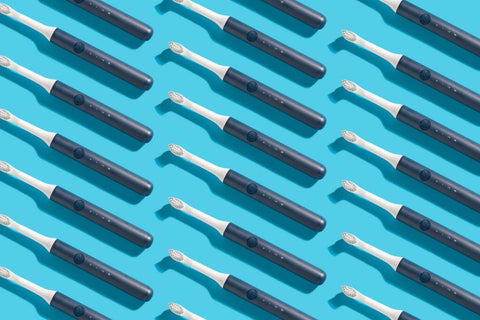
You're probably familiar with a manual toothbrush - it's been a staple in oral hygiene for decades.
But have you ever wondered how an electric toothbrush works?
In this blog post, we'll explore the technology behind the electric toothbrush, its benefits, and how to use and maintain it.
What is inside an electric toothbrush?

Battery-powered motor
One of the main components of an electric toothbrush is its battery-powered motor. This motor is what powers the toothbrush's movement, creating a mechanical vibration that moves the bristles back and forth.
The motor is usually located in the handle of the toothbrush and is powered by a rechargeable battery. When you turn on the toothbrush, the motor begins to rotate, causing the bristles to move at a high speed.
There are different types of motors used in electric toothbrushes, but the most common ones are magnetic and electric. Magnetic motors use a magnet to create motion, while electric motors rely on an electric current to generate movement.
How long do electric toothbrushes last
Circuit board
When you switch on the electric toothbrush or select a particular setting, switches on the printed circuit board are activated. These switches tell the motor how to move and are all implemented by a micro-memory chip on the internal circuit.
The circuit board is also used to indicate battery life or cleaning mode, as LEDs mounted on the board will activate when necessary.
It is important to note that not all toothbrushes have this feature and it varies depending on the model and brand of electric toothbrush.
How to clean electric toothbrush
Pressure sensors
Some brushes are equipped with a pressure sensor to help check your oral health.
The feedback is transmitted through the toothbrush when cleaning your teeth.
When too much pressure is applied to the teeth, the pressure sensor is activated and is usually displayed as an LED light.
When the pressure is released, the light will go out and the sensor switch will turn off.
Is it good to brush your teeth with electric toothbrush?

Advantages of Electric Toothbrushes
When it comes to oral hygiene, electric toothbrushes offer several advantages over their manual counterparts.
Electric toothbrushes are more efficient at removing plaque and reducing the risk of gum disease. The oscillating or rotating bristle heads of electric toothbrushes can reach areas that are difficult to access with a manual toothbrush, ensuring a more thorough clean.
Another advantage of electric toothbrushes is the convenience they offer. Many models come with replaceable brush heads, making it easy to maintain good oral hygiene without having to purchase an entirely new toothbrush.
KIWIBIRD electric toothbrushes also feature various cleaning modes, such as sensitive or whitening, allowing you to personalize your brushing experience.
Are electric toothbrushes better
What are the disadvantages of electric toothbrush?

Disadvantages of Electric Toothbrushes
While electric toothbrushes have numerous benefits, it is important to consider their potential disadvantages as well.
One common concern is the cost. Electric toothbrushes tend to be more expensive than manual toothbrushes, and the replacement brush heads can also add to the ongoing expenses.
However, it is worth noting that the long-term health benefits of using an electric toothbrush may outweigh the initial investment.
Some people may find the vibrations or movements of electric toothbrushes uncomfortable or even painful, especially if they have sensitive gums or teeth.
It is essential to choose a electric toothbrush toothbrush with adjustable speed settings or a sensitive mode to cater to individual needs.
How often change electric toothbrush head
Do you need to brush back and forth with an electric toothbrush?

Contrary to popular belief, it is not necessary to brush back and forth with an electric toothbrush. In fact, dentists recommend using a gentle circular motion to effectively clean your teeth and gums.
Start by placing the bristles of the electric toothbrush at a 45-degree angle against the gumline. Apply light pressure and move the brush head in small circular motions, ensuring that you cover all tooth surfaces. Remember to focus on each tooth individually, spending a few seconds on the outer, inner, and chewing surfaces. It is recommended to brush for a minimum of two minutes, evenly dividing the time between the upper and lower jaws.
While electric toothbrushes do most of the work for you, it is still crucial to pay attention to proper technique and avoid applying excessive pressure. Pressing too hard can lead to gum recession and enamel erosion over time.
Let the electric toothbrush do its job while you guide it gently, ensuring a thorough clean without causing any harm to your teeth and gums.
How to use electric toothbrush
Rotating or Vibrating Toothbrushes: Which is Better?

One question that often arises when considering electric toothbrushes is whether to choose a rotating or vibrating model.
Can you use an electric toothbrush with braces
The answer depends on personal preference and individual oral health needs.
Rotating toothbrushes, also known as oscillating toothbrushes, feature bristles that rotate in one direction and then reverse. This motion is believed to effectively remove plaque and provide a deep clean.
On the other hand, vibrating toothbrushes feature bristles that vibrate or pulsate, providing a gentle massaging action. This vibration helps dislodge plaque and food particles, offering a thorough clean. Some individuals find the vibrating sensation more comfortable, while others prefer the rotating motion.
Ultimately, both rotating and vibrating toothbrushes have been shown to be effective in maintaining oral hygiene.
The most important factor is choosing a electric toothbrush that you feel comfortable using and that enables you to consistently maintain good oral health practices.















